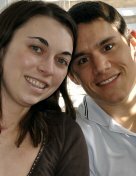A few years ago, on a day that had begun like any other, David stood up to leave a restaurant following lunch and was hit by a gentle wave of dizziness. Unaware that he was suffering a stroke, David took a deep breath and kept walking toward his car. “It came on slowly,” David recalls. “But by the time I got to my car my legs and arms had stopped functioning properly. I climbed into the back seat, thinking it would subside. But it didn’t subside.” With difficulty, David managed to get into the front seat and maneuver his cell phone into the hands-free phone holder that was mounted to the dashboard. Then he called the first person on the auto-dial.
That person happened to be Angie, one of his co-workers.
Fortunately, Angie answered, heard David’s voice, and within moments knew that something was wrong.
“At that point, I couldn’t speak and I couldn’t figure out why I couldn’t speak,” David says. "I knew very little about strokes."
Angie did. "I kept saying hello," Angie said. "He was trying to say something. At first I thought he was joking around. Then, no, David doesn’t joke around. When I heard him speak I knew what had happened. My mother had had a stroke."
Angie began asking David yes-and-no questions. Are you in your car? Are you at a restaurant? Are you in a parking lot? "I needed to find him," Angie said. “He obviously needed help. I tried to narrow it down to all his favorite lunch spots."
Again, luck was on David’s side. Directly in his line of sight was a sign that said Roly Poly sandwich shop. David was able to mumble the words out of the side of his mouth, and Angie and a few co-workers were there within five minutes.
As paramedics lifted David into an ambulance, he was confused and unable to move. He remembers hearing the EMT declare into his radio, "We’re bringing in a stroke victim." David also remembers thinking, "How could I be having a stroke?' He was only 41 years old.
With the EMT’s declaration, the Greater Cincinnati/Northern Kentucky Stroke Team’s finely honed system of emergency stroke care kicked into gear. David was rushed to the nearest hospital, St. Elizabeth Medical Center in Covington, Kentucky, where he underwent tests and received the clot-busting tissue plasminogen activator, or t-PA, within two hours. Dr. Matthew Flaherty, a Stroke Team neurologist who is affiliated with UC Neuroscience Institute at the University of Cincinnati and University Hospital, oversaw David’s care.
"Tissue plasminogen activator is the only FDA-approved treatment for acute ischemic stroke," Dr. Flaherty explains. "One key to the successful use of t-PA is rapid recognition of stroke symptoms. Because David arrived in the emergency room so early in the course of his stroke, I was able to evaluate and treat him quickly, and hopefully provide him the best chance of a good recovery."
How much t-PA David would receive was a tricky question because of his past medical history. As a high school student in 1978, David had developed a pinealoma, a benign brain tumor, which was eradicated at a New York hospital with cobalt radiation, a crude treatment by today’s standards. After consulting with members of David’s family and his previous neurologist, Dr. Flaherty settled on the t-PA dosage most likely to help David without triggering bleeding in the brain.
Unlike some patients, David did not experience an immediate recovery after the infusion of t-PA. But his condition stabilized, and he experienced steady, significant improvement during the next two weeks at Drake Center in Cincinnati. His goal was "to walk out of Drake with a cane" in time to join his family on their vacation on Cape Cod. He accomplished that goal and, after enjoying a trip to the ocean in a rented “beach wheelchair” with large inflatable wheels, he drove back to Cincinnati with his family.
But David still lacked mobility below his shoulder on one side, and the problem was not resolving. Then, in a pivotal development, his cousin, a stroke researcher at Harvard University, told him about the concept of mental imaging, a technique used by athletes in which they imagine themselves successfully executing a difficult maneuver over and over. “One night when I couldn’t sleep, I kept thinking about performing the OK sign with my thumb and index finger,” David recalls. "And in the morning, when my daughter came in to see me, I was able to generate a little bit of movement with my thumb and forefinger. It was an important step for me, because there was no movement at all before."
"New research in stroke rehabilitation, including studies ongoing in our community, nicely complement our research in acute stroke treatment," Dr. Flaherty says. "Both play an important role in improving the lives of stroke patients."
Today David’s life is near normal. He is back at work, and he has resumed playing the guitar for his Sunday school classes, although not as fluidly as before. He remains vigilant about his body and how he feels. "If I get up too quickly and feel dizzy, I stop a moment and take note of it," he says.
Equally important, he takes every opportunity to share his story with others. David’s stroke symptoms were dramatic because his stroke occurred in an important part of his brain. Quick recognition of his stroke, along with quick evaluation in the emergency room and prompt treatment, gave him the best possible chance of a good recovery. It is a message he very much wants to convey.
He also wants to give something back to the doctors, nurses, and therapists who helped him. "I’ve gone to see a couple of people who have had strokes," he says. "If I can help motivate someone, that’s important to me. Motivation and keeping sight of your goals play a huge part in your recovery."
"I’ve never seen anybody fight so hard and come back from something," Angie says. "He has such a fighting, winning spirit. He’s a remarkable person. He’s definitely someone to look up to, to admire. He didn’t complain at all, didn’t blame it on anyone. He took it in stride and did what he had to do."
Adds Dr. Flaherty: "David has turned a difficult experience into a very positive one for many people around him. His determination and attitude have inspired those of us who treat stroke, as well as others who have experienced a stroke."
 RSS Feed
RSS Feed

